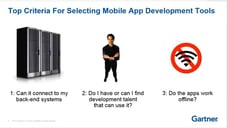
Tips for Scaling Mobile App Development
If you’re not able to meet the demand in your business for developing mobile apps, you’re not alone. The gap between companies needing mobile apps and the ability to deliver them is growing fast. In fact, a Gartner report, “The Key Fundamentals Required to Scale Mobile App Development,” warns that, “By 2020, market demand for mobile app development services will be three times greater than internal IT organizations' capacity to deliver them.”
A Gartner survey done on enterprise mobile app development, done in 2016, found that companies, on average have released only eight mobile apps, “with a significant number of respondents not having released any mobile apps.” The report says, “This is an indication of the nascent state of mobility in most organizations, with many organizations questioning how to start app development in terms of tools, vendors, architectures or platforms, let alone their ability to scale up to releasing 100 apps or more.”
But it doesn’t have to be that way. The Gartner report offers the following advice for scaling mobile app development efforts at your organization.
Prioritize Scaling Mobile App Development So Quality Is Not Sacrificed for Speed
The report notes that apps are typically built on a first-come-first-served basis. That means that the most important apps often take a back seat because they were late to the queue, even though they should get top priority. The report says, “This lack of value-driven prioritization leads to inefficient use of IT resources and degradation in the quality of apps delivered.”
So businesses should factor in two key pieces about each app to be developed: Whether it will be easy or hard to build, and how high or low an impact the app will have on the organization. Based on that, enterprises will be able to be properly prioritize which apps should be built first.
Create an Agile API Layer to Optimize Mobile Integration
Integration is often the most time-consuming and difficult part of building an app. This leads to delays in app development. So Gartner recommends building an API layer to make integrations easier and faster. It recommends several different methods: using enterprise mobile back-end service tools, using API management tools for large-scale deployments, and using a rapid mobile app development (RMAD) tool.
Use RMAD Tools to Deliver More Apps
RMAD tools use a low-code or coding-optional approach, allowing someone with little experience to quickly build a mobile app, yet also let experienced developers add more advanced code, if needed. They’re end-to-end tools for building mobile apps, including backend integration and front-end app development. Using them, the report says, can dramatically speed up mobile app development.
Use a Product Management Model to Mobile Agile Development
Companies need to treat mobile apps as products, not just apps, Gartner says. It warns, though, that doing that mean “more than just applying agile development methodologies. It should include best practices for product management in general.”
That means making sure product managers in charge of apps are given the proper authority, and ensuring that collaboration among different groups is constant and ongoing.
Know more information about the Gartner report.
Alpha Anywhere is one of the most highly rated RMAD tools. InfoWorld named it a top mobile app development leader and enterprises give it a perfect score on Gartner Peer Insights.
More details about Alpha Anywhere’s RMAD capabilities.







Comment